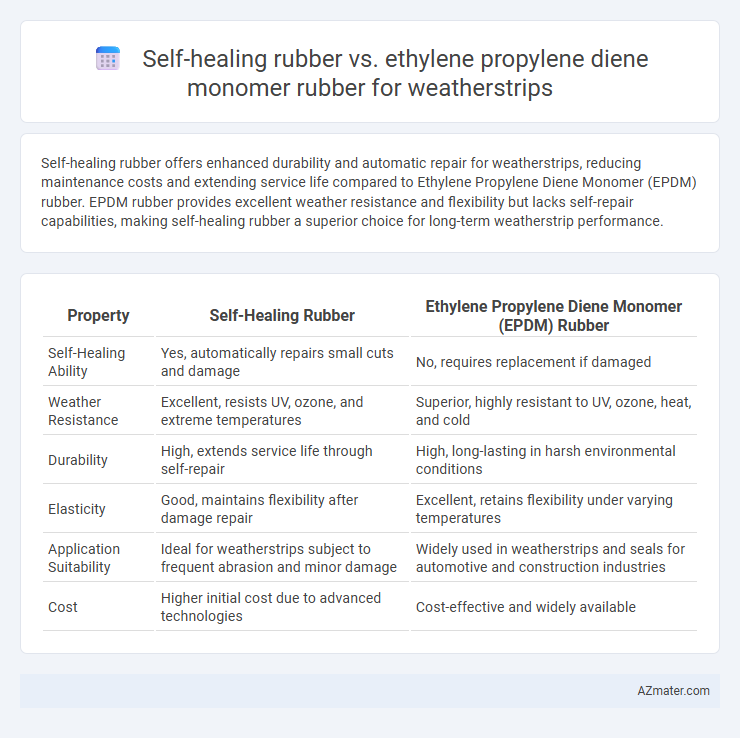Self-healing rubber offers enhanced durability and automatic repair for weatherstrips, reducing maintenance costs and extending service life compared to Ethylene Propylene Diene Monomer (EPDM) rubber. EPDM rubber provides excellent weather resistance and flexibility but lacks self-repair capabilities, making self-healing rubber a superior choice for long-term weatherstrip performance.
Table of Comparison
| Property | Self-Healing Rubber | Ethylene Propylene Diene Monomer (EPDM) Rubber |
|---|---|---|
| Self-Healing Ability | Yes, automatically repairs small cuts and damage | No, requires replacement if damaged |
| Weather Resistance | Excellent, resists UV, ozone, and extreme temperatures | Superior, highly resistant to UV, ozone, heat, and cold |
| Durability | High, extends service life through self-repair | High, long-lasting in harsh environmental conditions |
| Elasticity | Good, maintains flexibility after damage repair | Excellent, retains flexibility under varying temperatures |
| Application Suitability | Ideal for weatherstrips subject to frequent abrasion and minor damage | Widely used in weatherstrips and seals for automotive and construction industries |
| Cost | Higher initial cost due to advanced technologies | Cost-effective and widely available |
Introduction to Weatherstrip Materials
Weatherstrip materials such as self-healing rubber and Ethylene Propylene Diene Monomer (EPDM) rubber offer distinct advantages for sealing applications. Self-healing rubber enhances durability by automatically repairing minor damages, extending the lifespan of weatherstrips in dynamic environments. EPDM rubber provides excellent resistance to ozone, UV radiation, and extreme temperatures, making it a reliable choice for long-term outdoor sealing performance.
Overview of Self-Healing Rubber
Self-healing rubber for weatherstrips utilizes advanced polymer networks that autonomously repair micro-cracks and damages, enhancing durability and extending service life. Unlike Ethylene Propylene Diene Monomer (EPDM) rubber, which relies on its inherent chemical stability and weather resistance, self-healing rubber actively recovers from mechanical wear and environmental stress. This innovative material reduces maintenance frequency and improves sealing performance in automotive and industrial applications.
Ethylene Propylene Diene Monomer (EPDM) Rubber Explained
Ethylene Propylene Diene Monomer (EPDM) rubber is a synthetic elastomer renowned for its exceptional resistance to weathering, ozone, UV rays, and temperature extremes, making it ideal for weatherstrip applications. Unlike self-healing rubber, EPDM offers superior durability and long-term performance in automotive and construction sealing due to its excellent elasticity and resistance to environmental degradation. Its chemical structure includes ethylene, propylene, and diene monomers, which contribute to enhanced flexibility and resilience under harsh outdoor conditions.
Key Properties Comparison: Self-Healing vs EPDM
Self-healing rubber features intrinsic repair mechanisms that restore material integrity after damage, enhancing longevity and reducing maintenance for weatherstrips, while EPDM rubber offers excellent resistance to UV, ozone, and extreme temperatures with stable mechanical properties. Self-healing rubber exhibits improved crack healing and flexibility, whereas EPDM provides superior chemical resistance and durability in harsh environmental conditions. The choice between self-healing rubber and EPDM depends on prioritizing dynamic self-repair capabilities versus proven long-term weather and chemical resistance for weatherstrip applications.
Weather Resistance and Durability Analysis
Self-healing rubber offers enhanced weather resistance by autonomously repairing micro-cracks caused by UV exposure and temperature fluctuations, significantly extending the lifespan of weatherstrips. Ethylene propylene diene monomer (EPDM) rubber demonstrates exceptional durability and resistance to ozone, UV rays, and extreme temperatures, making it a standard material for weatherstrips in automotive and construction applications. Comparative analysis reveals that while EPDM excels in broad environmental resilience, self-healing rubber provides superior long-term integrity through active damage recovery, reducing maintenance frequency.
Self-Healing Capabilities in Automotive Applications
Self-healing rubber offers advanced repair capabilities by autonomously restoring micro-cracks and abrasions, significantly extending the lifespan of automotive weatherstrips. In contrast, Ethylene Propylene Diene Monomer (EPDM) rubber provides excellent resistance to UV rays, ozone, and extreme temperatures but lacks intrinsic self-repair properties. Integrating self-healing rubber in weatherstrip applications enhances durability and reduces maintenance costs by minimizing material degradation under harsh environmental conditions.
Cost-Effectiveness and Manufacturing Considerations
Self-healing rubber offers superior durability and reduced long-term maintenance costs for weatherstrip applications compared to Ethylene Propylene Diene Monomer (EPDM) rubber, which is traditionally favored for its low initial cost and established manufacturing processes. EPDM rubber benefits from widespread industrial acceptance, streamlined extrusion and molding techniques, and a cost-effective supply chain, making it a practical choice for large-scale production. However, the advanced polymer chemistry in self-healing rubber can increase manufacturing complexity and upfront expenses, potentially offset by longer service life and fewer replacement cycles in cost-effectiveness analyses.
Environmental Impact and Sustainability
Self-healing rubber offers enhanced sustainability for weatherstrip applications by extending product lifespan and reducing waste through its autonomous repair capabilities, thereby lowering environmental impact. Ethylene propylene diene monomer (EPDM) rubber, while highly durable and widely used due to its resistance to UV, ozone, and weathering, is derived from non-renewable petrochemicals and lacks self-repair properties, contributing to higher material turnover and waste generation. The integration of self-healing materials in weatherstripping significantly advances circular economy principles by minimizing landfill contributions and resource consumption compared to conventional EPDM rubber.
Performance in Extreme Climate Conditions
Self-healing rubber exhibits superior performance in extreme climate conditions due to its ability to autonomously repair micro-cracks, maintaining elasticity and sealing properties under prolonged UV exposure and temperature fluctuations. Ethylene propylene diene monomer (EPDM) rubber offers excellent resistance to heat, ozone, and weathering but lacks intrinsic self-repair capabilities, leading to potential degradation over time in harsh environments. The self-healing properties enhance durability and lifespan of weatherstrips in regions with severe temperature variations and intense solar radiation, reducing maintenance frequency compared to conventional EPDM rubber.
Future Trends in Weatherstrip Innovation
Self-healing rubber offers significant potential for weatherstrip applications by extending product lifespan through its ability to autonomously repair minor damages, reducing maintenance and replacement costs compared to traditional Ethylene Propylene Diene Monomer (EPDM) rubber. Innovations in polymer chemistry and nanotechnology are driving the development of weatherstrips with enhanced durability, environmental resistance, and self-healing capabilities, tailored specifically for automotive and construction uses. Future trends prioritize sustainability and smart materials, with self-healing rubber emerging as a key solution to improve weatherstrip performance under extreme weather conditions while minimizing environmental impact.

Infographic: Self-healing rubber vs Ethylene propylene diene monomer rubber for Weatherstrip
 azmater.com
azmater.com